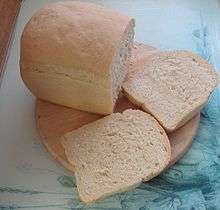White bread
 | |
| Type | Bread |
|---|---|
| Main ingredients | Wheat flour |
| Other information | glycaemic load 37 (100g)[1] |
White bread typically refers to breads made from wheat flour from which the bran and the germ layers have been removed (and set aside) from the whole wheatberry as part of the flour grinding or milling process, producing a light-colored flour.[2] This milling process can give white flour a longer shelf life by removing the natural oils from the whole grain. Removing the oil allows products made with the flour, like white bread, to be stored for longer periods of time avoiding potential rancidity.
The flour used in white breads may be bleached—that is, lightened further—by the use of chemicals such as potassium bromate, azodicarbonamide, or chlorine dioxide gas to remove any slight, natural yellow shade and make its baking properties more predictable. This is banned in the EU. Some flour bleaching agents are also banned from use in other countries.
In the United States, consumers sometimes refer to white bread as sandwich bread and sandwich loaf.[3]
White bread contains 1/2 of the magnesium found in whole-wheat bread.
White bread fortification
While a bran and wheat germ discarding milling process can help improve white flour's shelf life, it does remove nutrients like some dietary fiber, iron, B vitamins, micronutrients[4] and essential fatty acids. Since 1941, however, fortification of white flour-based foods with some of the nutrients lost in milling, like thiamin, riboflavin, niacin, and iron was mandated by the US government in response to the vast nutrient deficiencies seen in US military recruits at the start of World War II.[5] This fortification led to nearly universal eradication of deficiency diseases in the US, such as pellagra and beriberi (deficiencies of niacin and thiamine, respectively) and white bread continues to contain these added vitamins to this day.[6]
Folic acid is another nutrient that some governments have mandated is added to enriched grains like white bread. In the US and Canada, these grains have been fortified with mandatory levels of folic acid since 1998 because of its important role in preventing birth defects. Since fortification began, the rate of neural tube defects has decreased by approximately one-third in the US.[7][8][9]
See also

- Brown bread, a bread that was considered undesirable in early-19th-century Europe
- Chorleywood bread process, another common process for mass-produced bread
- Flour treatment agent
- Graham bread, an early reintroduction of an unbleached bread
- Maida flour, a bleached flour typically used to make a white bread in India
- Plain loaf
- Pullman loaf, bread baked in a lidded pan, responsible for square-shaped slices
- Rye bread, a bread that can be darker or neutral in color
- Sliced bread, pre-sliced and packaged bread, first sold in 1928
- Vienna bread, baking processes that lead to lighter, less sour breads
- Whole wheat bread, one common alternative to white bread

References
| Wikimedia Commons has media related to White breads. |
- ↑
- ↑ NPCS board (2012-10-01). Manufacture of Food & Beverages (2nd Edn.). Niir Project Consultancy Services, 2012. ISBN 9789381039113.
- ↑ Mercuri, B. (2009). American Sandwich. Gibbs Smith, Publisher. p. 9. ISBN 978-1-4236-1192-9.
- ↑ "Grains - What foods are in the grain group?". ChooseMyPlate.gov. USDA.gov. 2009-10-01. Retrieved 2012-01-06.
- ↑ "Position of the American Dietetic Association: Fortification and Nutritional Supplements". Journal of the American Dietetic Association. 105 (8): 1300–1311. 2005. doi:10.1016/j.jada.2005.06.009.
- ↑ "Southern Medical Journal". Journals.lww.com. 2010-09-30. Retrieved 2010-11-07.
- ↑ Williams, L.J., et al. Decline in the prevalence of spina bifida and anencephaly by race/ethnicity: 1995-2002. Pediatrics. 2005; 116: 580-586.
- ↑ "Cambridge Journals Online - Public Health Nutrition". Journals.cambridge.org. Retrieved 2010-11-07.
- ↑ Grosse, S., et al. Reevaluating the benefits of folic acid fortification in the United States: economic analysis, regulation, and public health. Am J Public Health. 2005; 95: 1917-1922.
| Look up white bread in Wiktionary, the free dictionary. |